Travelogue of Mysore—A Week in and Around the Historical City
After checking out of a tiny room in a peculiar highway hotel outside Mysore, my partner Sagar and I both took deep breaths.
“I’m so relaxed after getting out of that place. We shouldn’t have stayed there for three nights,” I said.
He replied, “Yeah, like a weight is lifted off my head.”
Our relief could be accounted to the sleepy staff who upon seeing us return from lunch and standing outside the hotel door they had locked exclaimed, “You’re not going sightseeing?” Sagar and I waited on two tiny iron chairs in the airless lobby while the housekeeping woman haphazardly cleaned our room, leaving the garbage as is, the bed unmade, and damp towels lying in a coil. Then I squeezed onto the tiny desk in the corner, and Sagar managed to work from the bed.
As we drove to a highly-praised dosa place in Mysore downtown, watching the city go by us, the hotel room was already a thing of the past. We discussed our options. Either we could look for a good hotel in the city centre near the historical places—the city being the the capital of the Kingdom of Mysore from 1399 to 1947 or drive further on. Our eyes were on Kerala. I had traveled to Mysore with my parents thirteen years ago and seen its major attractions: the Mysore Palace, the city zoo, gardens et cetera. My partner also didn’t care much about exploring every nook and corner of Mysore. We had been to Rangnathittu Bird Sanctuary twice on two different times and a day earlier strolled around an unmarked dam and lake, spotting hundreds of migratory birds.
“Let’s see how we feel after breakfast,” we said to each other.
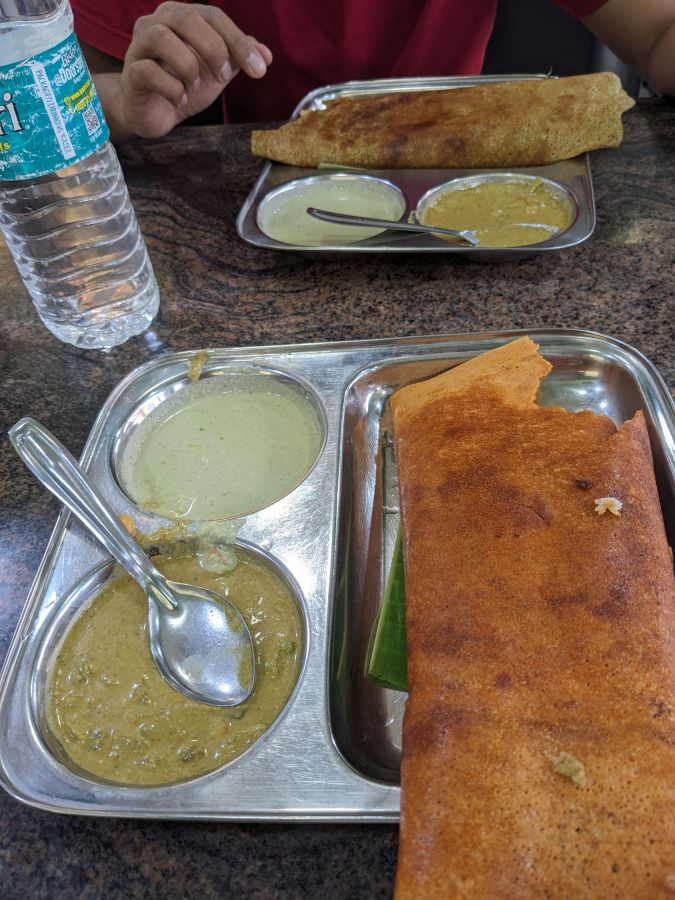
The masala dosa was a bit limp, not like the super crispy Karnataka dosa I was expecting. The place was, sadly, overhyped.
After tea, on the dusty road, under a tree, we sat talking, planning our day. My partner had taken the day off, given how impromptu we were being.
“Do you want to drive to Bandipur or Nagarhole today?” He asked, as we had been asking each other since morning.
“No. I’m so tired I don’t think I can drive today. It’s a long drive. And I don’t think even you’re up for driving for long hours.” I rubbed my eyes which had suddenly become heavy, as if wanting to close.
“No I’m not.” He replied, with a tired look in his eyes.
“Let’s look for a hotel and stay.” After the dosa, my body had slowed down, screaming for rest and sleep. Imagining myself lying down on a bed was bringing immense relief.
We both started browsing Google Maps for accommodations in Mysore. He was looking at booking websites.
Finding guest homes and family stays in India for three years, we are both wary of accommodations. Some don’t clean, many don’t provide drinking water, others are noisy or intruding, and so on. Somewhere staff don’t care, other places don’t have parking, and sometimes the toilet doesn’t flush. I can filter out well-reviewed properties just by a few red flags that I know would be too glaring in physical reality.
I found Mannar, a hotel with a 4-star rating after hundreds of reviews. None of its reviews said dirty, uncaring staff, noise et cetera. One or two poor reviews when the experience might have been spoiled due to a one-off reason didn’t worry me. Parking was mentioned.
We didn’t call. Fifteen minutes later, we squeezed into a narrow, busy street and parked outside the hotel across from a dung-smeared cow munching grass from a round stone trough.
The receptionist was a sweet local guy who showed us a room—which was clean, with fresh linen, and adequately equipped—and said we could book online. Offline, they couldn’t give the double room for less than 1700. I booked online for two days at 1550 per night. (Go here to find Mannar on Booking.)
The room was spacious, even though the study was in a corner, and one couldn’t open the window because of the blaring air conditioning or some generator outside. The window sill was grimy too. But it was still all good, and after getting a towel and so on, we both went to bed. I sank into the soft mattress, and my body let out a sigh of relief.
After about an hour and a half, my partner started waking up. It was three pm. I couldn’t get up.
I woke up at four, aware that my body had been drained of all energy. We went downstairs to eat. Mannar had a restaurant by the same name. One of those typical South Indian places where they serve meals, dosa, idli, North Indian vegetables and curry, juices, and tea/coffee.
The restaurant had four steel tables on the ground floor, and more above. A pious attendant with his forehead marked with tilaks took our order at the billing. Downstairs was self-service. Our order of palak paneer (spinach cottage cheese), dal, and two rotis came quickly. The food was lip-smacking good even though both the curries were North-Indian preparations—which is a point to note as finding chefs from another region isn’t always easy, and most Northern and Southern joints don’t do justice to each other’s food. I was impressed with the simplicity and non-oiliness of the dal, the rich and garlicky palak paneer overflowing a little pot was a good surprise, and as we weren’t expecting the roti to be tandoori (cooked in a clay oven), we couldn’t be happier. Upon our request, lemon and onion pieces, without which this girl doesn’t get the essential crunch and which she had been eating in every meal with her father, were provided too.
What a good lunch in the middle of the day when we least expected it!
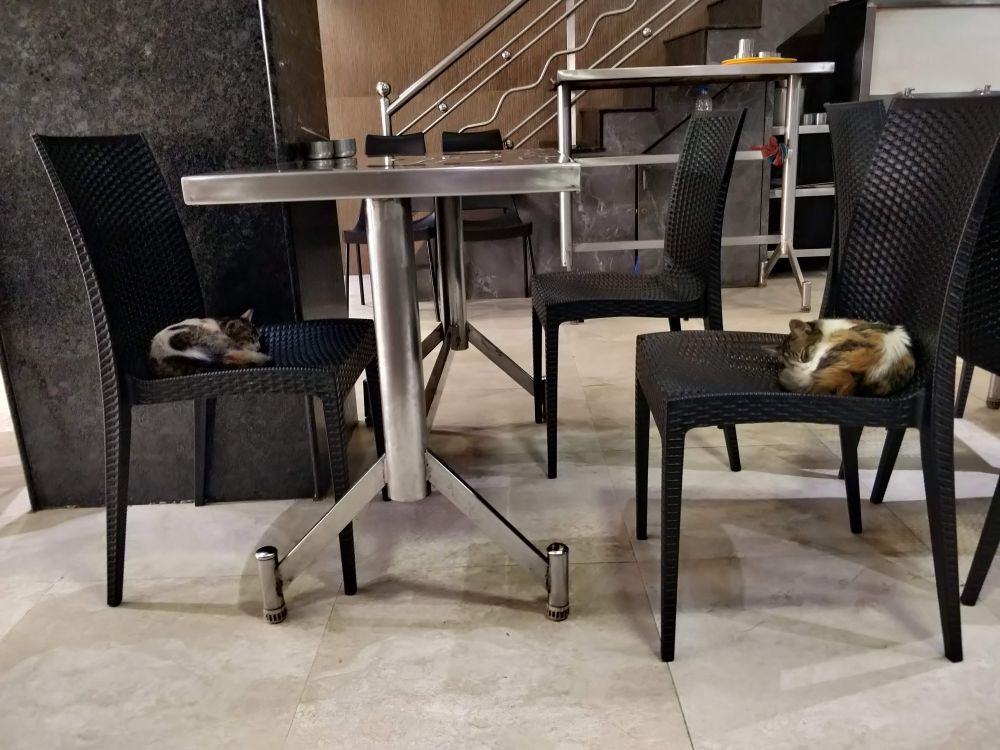
I don’t remember if we had tea or not. Maybe we did. We both went back to the room.
“You aren’t going to the Mysore Palace?” I asked as we got inside.
“No. I’ll rest.”
Whenever my partner says he will leave and I have the whole room to myself, I am happy. “A few hours of solitude” matters to someone who travels with her companion throughout and both work and live in the same place around the year. We even visit my parents together. Our friends together. And so it means a lot when he or I go away for a bit, and the other is by herself, exploring the place solo or living by oneself. But as we have been on the move since 2021, having a car for a home, we also understand each other’s desire to just be in a nice, clean, cosy, cool room.
The mystery of being tired was solved when I got my period in the evening.
The next day, I urged my partner to take another leave from the office to travel in Mysore, to see it a bit. He agreed. After breakfast, he walked to the Mysore Zoo, and I stayed put, working, writing, and publishing. At lunchtime, I walked out, giving the key to reception for cleaning. I couldn’t stop at the Mannar restaurant, having eaten the past three meals at it. I walked past it, ignoring the smell of fresh sambhar, filter coffee, and cow pee.
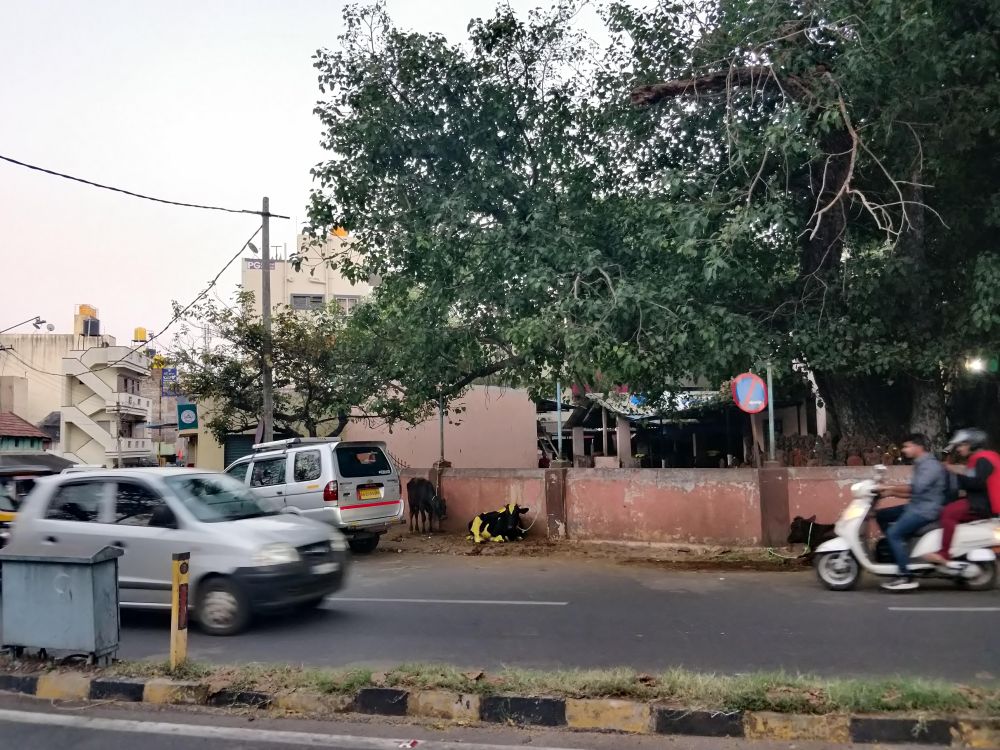
I went around a couple of noisy, sun-scorched streets and across from the food place Maddur Tiffany Since 1991, I crossed the road. With its separate tea/coffee counter, lunch meals, and crowd, it was a quintessential Karnataka eatery. Though there was a small self-service placard at the counter, I plonked on a chair. Some women servers were running around in blue aprons. Maybe one had to pay a little extra for service. Periods were sucking even the last ounce of me, and I was okay with paying more.
The dal khichdi didn’t come with curd or pickle. I asked, and the server provided both in two little bowls, with a smile. The restaurant was surrounded by hospitals. Medical students were poring in to eat, unbothered to remove their white knee-length aprons. A few sat across from me, carrying the quartered steel plates full of vegetables, dal, papadum, rice, chapati, pickle, and curd. Tables were occupied by locals and foreigners alike. Wall-mounted fans whirled non-stop. I ate slowly, sipping my orange juice in between. I didn’t visit the palace. I couldn’t walk too far. But this is also good. This is as local as it gets.
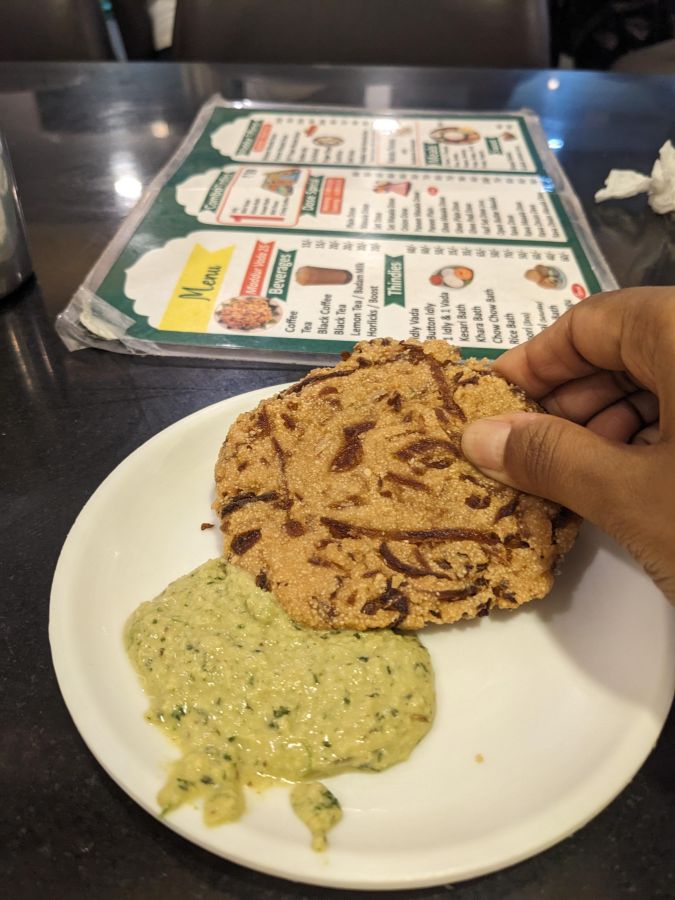
Back at the hotel, my room was clean. All I had to ask for was a clean foot mat and toilet paper. After resting a bit, I logged into my laptop and ordered tea. Sagar also came back for a little break in between his Mysore tour. I doubled the order of tea; it came in little cups but hot. Then he was gone—everything being so near he could walk everywhere, and I was writing again.
Just a little nugget of insider information: Walking is one of those keystone habits that overflow into all aspects of life, changing everything we do. So we walk to places we want to see, to eat, and many times park away and walk the last stretch of the distance to avoid parking hustles in a crowded place. I would have said travel made me change into a walker but I have always loved to walk and now my partner has given in too.
We walked to a restaurant for dinner. It was one of those fine-dining places where half of the usual quantity of lentils cost twenty-five per cent more. We loathe such places and avoid them at any cost. But that evening we were lazy and hungry, and Sagar was lured by the paneer tikka that the restaurant’s online menu proudly displayed.
When the tie and shirt-donning server came, Sagar desperately asked for paneer tikka, and we added dal fry, dry potato, and two rotis to the order: all to be made less spicy and less oily, as always. (you can read more on healthy living in the linked article.)
The order took a long time. My stomach grumbled, and every time we asked the server—who was different from the guy who had taken the order, he assured us, “Two minutes, madam.” Agreed that the place had about twenty tables, but the various managers, waiters, and people who took the order were a bit too many. None of them willing to stop by, paying attention, or alert but all standing here and there solo or in their little crowds, avoiding eye contact, talking amongst themselves, or looking interested but still not responding.
“They should really reduce their staff.” Sagar and I were being wicked.
At least, the paneer tikka was good, with charred pieces of green pepper and onion. Its accompanying mint chutney was minty, which is in itself a big deal these days. Biting into thick pieces of coal-cooked paneer, my partner told me about the zoo, the Mysore palace, and other places he had seen.
“Leopard, lion, tiger, hippopotamus, elephants, giraffe, zebra, panther…”
“There was a panther?” I cut him, upset that I missed seeing the big black beautiful cat which I had never seen in the wild. “It’s okay. I don’t want to see captive animals.” I meant it.
The rest of the places I had seen with my parents in 2010. I hired a taxi from Bangalore that drove us to Mysore and took us around the city, stopping at the popular Vrindavan garden, the Mysore palace, and the zoo for as long as we liked. At night, we returned to Bangalore. While driving back, I asked the driver to turn around the car so we could see the palace lights that came on every night for an hour or so. The 100-year-old building shone as gold in night lights. It was all beautiful.
“The palace was beautiful. It had a lot of carvings, galleries, and antique cars. I’ve many pictures. I’ll show you.” Sagar was happy with his solo day out.
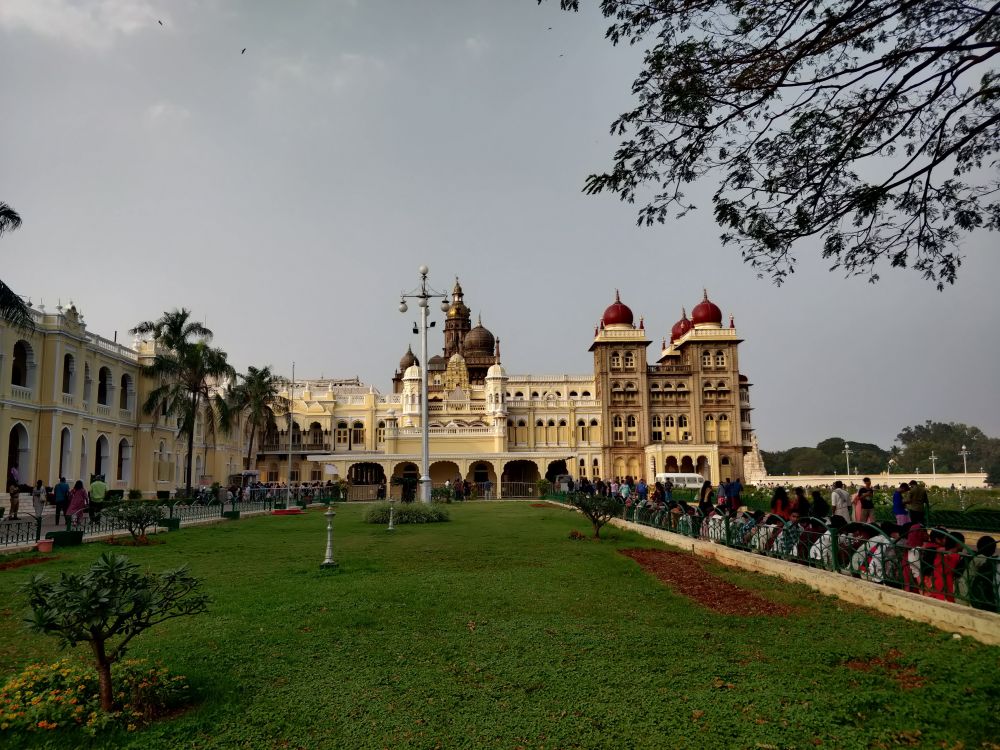
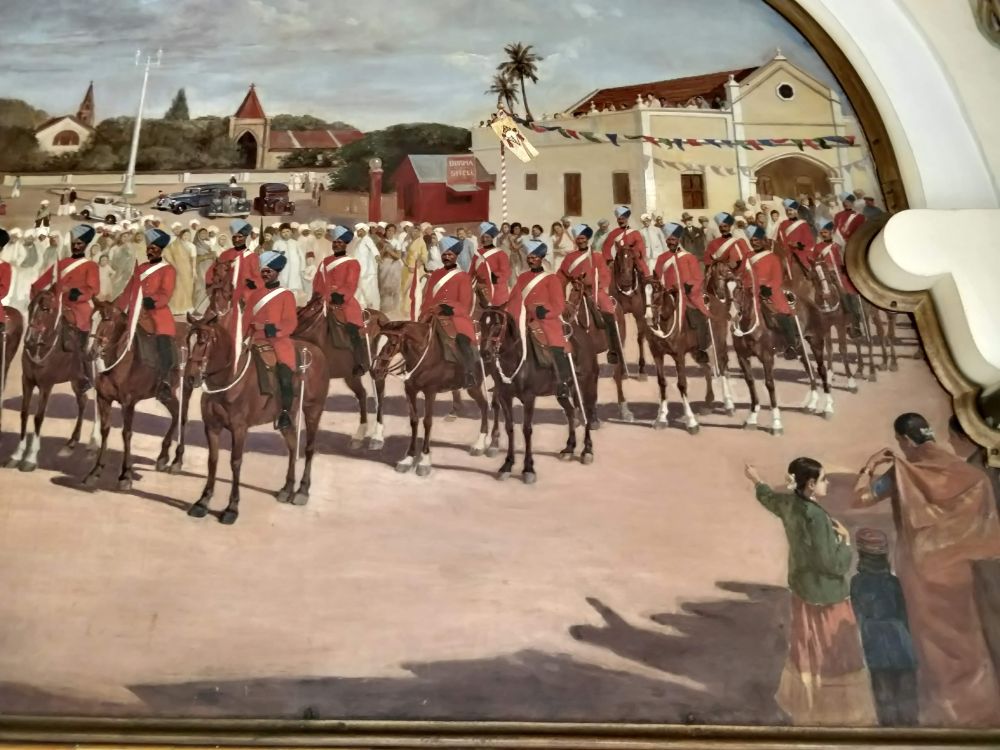
“Hey, I booked for two more nights. They can give us an upstairs room.” I remembered.
“Good. So we are sorted for a couple of days.”
“Yup,” I said as tandoori roti, dal, and cumin potato were brought to our table. The dry potato preparation is different everywhere in India. This one was with tomato, onion, and green chillies, a bit oily but delicious, perhaps because it was oily.
We got a surprise when the bill came. The restaurant charged us for the onion and lemon. “Never again,” we renewed our pledges of never visiting a fine dining sort.
We walked home relieved that we were stable for a few more nights, happy to explore and work from one place. That new room would be a disaster but for then we slept with the surety of a good roof above our heads for a little longer.
When you are on the road for as long as we have been, you don’t always want to get going. You don’t want to move every day. Tomorrow is not an opportunity to see a new place. The comfort of a decent roof above your head counts too. Especially on periods and on work days, when we prefer to be slow and stay put. It was both since Sagar couldn’t take any more holidays.
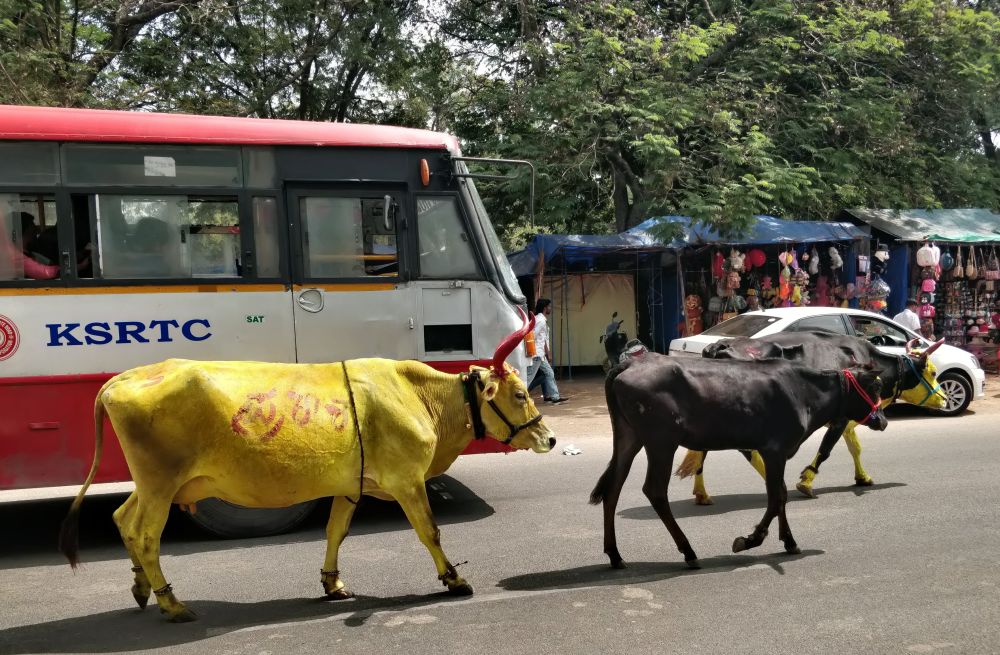
The next morning we had breakfast at Maddur Tiffany. When we checked into the new room, we had to get the floor mopped and the bathroom seat cleaned. The staff took half an hour to do both. All the rooms were smoking rooms, and this one smelled of smoke. We asked for a freshener. Even though we had seen the room before shifting into it, we missed these little details and the smell too. Perhaps we had started trusting the hotel’s housekeeping system.
All done, and the staff having assured me that the pale, stained duvet and bedding had been changed, I was still not sure. The duvet gave off the smell of smoke and was falling off its covers. But I ignored it all and wrote.
Lunch was at home: we ordered kadhi (chickpea flour with curd), bhindi fry (okra), and aloo gobhi (cauliflower potato) from Kapoor’s Cafe. The packets came with onion and lemon, and we had salt to sprinkle. The food was tasty even if heavy on my fragile stomach.
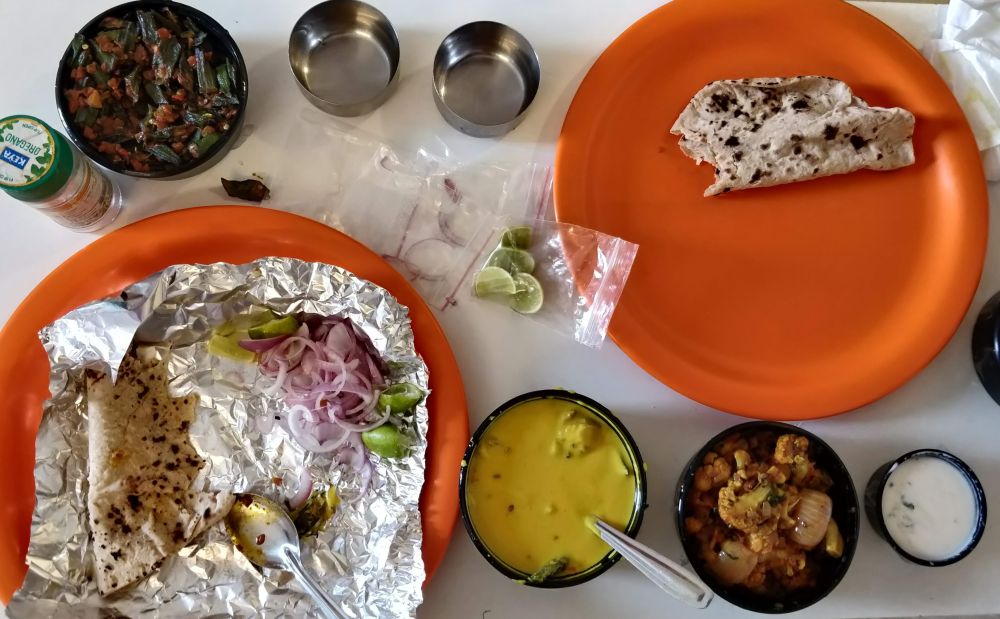
The biggest disaster was awaiting us though.
Around four, when I lay down, the duvet still reeked of smoke. The bedding was stained, not like “these marks don’t go in the laundry,” and more like, “These are fresh spots.” I sprang up, my mouth cringed and body revolting.
“They haven’t changed the bedding.” I pursed my lips. Sagar sighed and laid back in his chair.
Such a realisation and break of trust is disheartening on the road. There is no home to go to. The road is the home. We depend on guesthouses 24*7 all year. When a miss-happening seems to suggest our itinerant lifestyle is not sustainable, our spirits start to break, or break, depending on how many bad experiences we have had recently and if tomorrow looks better.
I didn’t cry like I did that afternoon in the highway hotel when we returned to find the room dirty, the main gate locked, and the staff’s query that why had we returned and not gone sightseeing. We can’t go sightseeing every day; we have to work too. On top of everything, a misunderstanding between my partner and me broke the dam loose.
I requested the staff to change the sheets and all. Though they first kept insisting that the smell was from the room below us, over time the cleaning staff concurred that yes, something had gone wrong and so the bedding wasn’t changed. They said it all in hushed tones and stunted sentences though. They might not have admitted to the carelessness if I didn’t insist they smell the duvet themselves. While four people bustled about in our room, cleaning, changing, and wiping, we went to have tea downstairs. When we went up, everything was fine and fresh.
“Let’s not get cleaning done tomorrow.” I said to Sagar.
“Please, no. Thank you.” He sighed and put his head back.
Even the privilege of daily housekeeping is not a good thing, as long-term travelers we testify.
Having cooked meals for many days, I munched raw radishes, carrots, and tomatoes for dinner. My stomach bloated up. Though I often eat unexplainable amounts of salads late into the day, the periods had rendered my stomach weak.
“I don’t feel so good either,” Sagar put a hand on his tummy.
“Maybe the lunch we ordered had something.”
Whatever it was, we slept soundly. I think I had nightmares about being stuck in a dirty room somewhere or something of the sort.
The staff came to clean at noon without calling. We let them in even though they caught us at a bad moment—it’s not every day the housekeeping itself shows up to clean. I was in a sleeveless shirt: something people notice in that part of the world, our things were strewn around, and even a couple of toilet papers that we had saved for later were kept out. We quickly put things in their right place, were happy for the impromptu cleaning, and that was that.
Lunch was at our Mannar restaurant: a considerate woman took our order and requested us to sit, perhaps we ordered spinach cottage cheese again, and it was all good. Every time we went to the restaurant, we also filled our water bottles from its cooler. Why bother the staff with things one can do oneself?
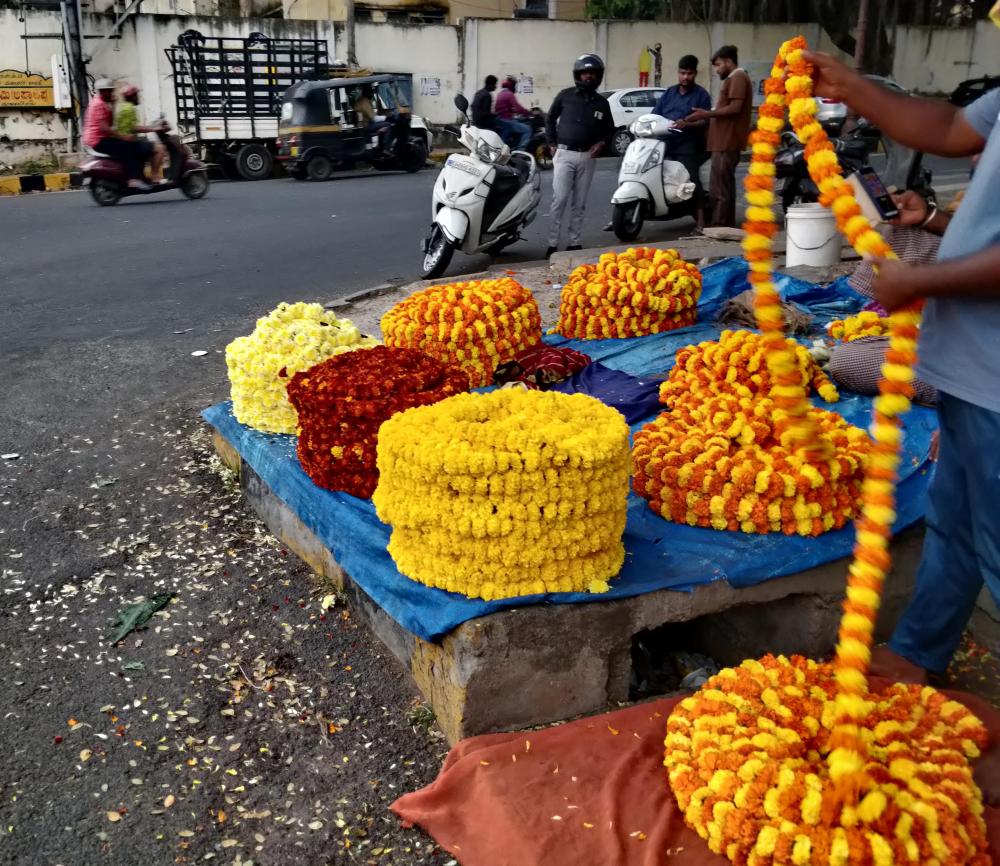
This was our fourth night in Mysore. We wanted to drive onward the next day. The universe has its own plans for us though.
The next morning, we checked out around ten am in all glory. At the reception, I relayed our smoky check-in story to the kind guy who had checked us in the first time.
“But you could have told us. We could have shifted you to another room. The smell must be from downstairs though.” The guy insisted. One house boy in a white shirt and pants, the hotel dress, listened to our conversation intently. Mannar had many house boys, and they ran up and down the stairs continuously, dozing in between on a mat in a room on the first floor and some outside it on a chair. At least they had a room, for women cleaners sat on the stairs to rest.
When everything was explained, the receptionist apologised and was a bit surprised. At least, the hotel cared for feedback.
Sagar drove to an old restaurant famous for its dosa and functional for ninety years, as the owner-in-charge told us later. The street was so narrow that we parked outside a park 200 m away from the restaurant and walked to it.
‘Old Original Hotel Vinayaka Mylari since 1938’ had a queue outside but within minutes we were seated across from a foreign couple who had as much as we did: three benne (butter) dosas shared amongst themselves. Though spongy and delicious, this butter dosa wasn’t as good as the one we ate in its place of origin, Davanagere, a couple of years earlier. That one was stuffed with mildly spiced potatoes, this one with a spicy mix of vegetables. That was crispy with a strong aroma of butter, this one was softer and less buttery. But the coconut chutney was fresh, and so we slurped and slurped. The coffee was thick, creamy, and strong too.
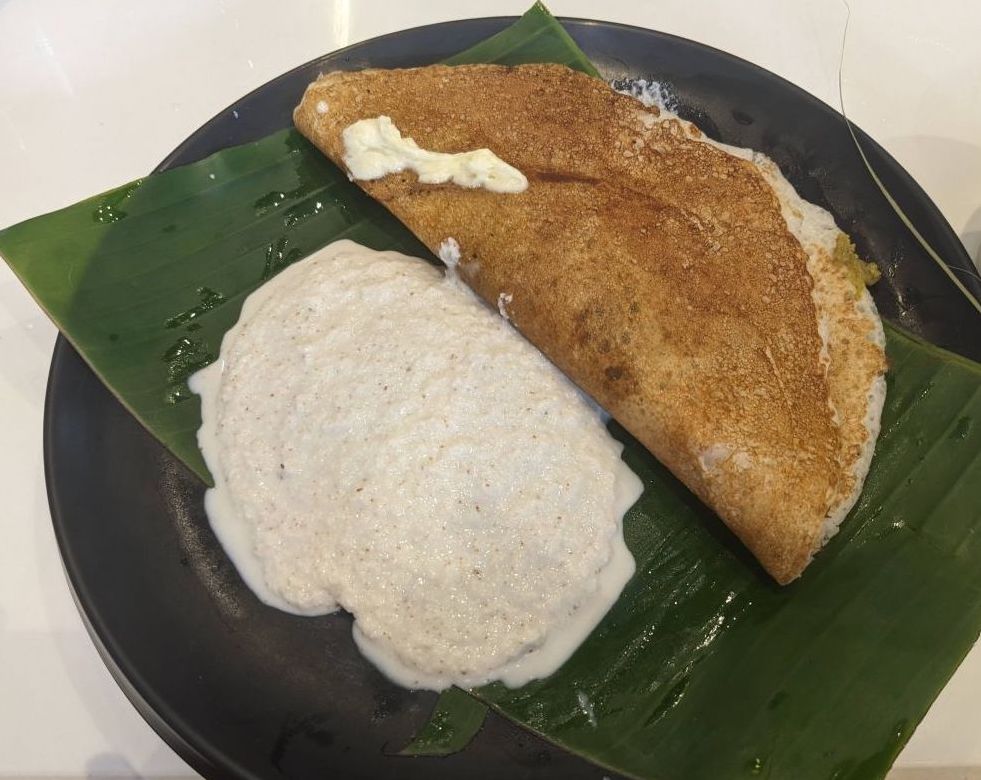
The server, as many servers in many places, didn’t tell us the other things they had. But plates of plain dosa, kesari bath, and khara bath were going around as well.
A ball of yellow ghee sweet: the kesari bath on a plate enticed us. We ordered one. As I put one spoonful in my mouth, all my body danced in pleasure. The kesari bath was sweet, soft, and drenched in ghee as any kesari bath should be. My mouth crunched upon some pineapple pieces, a good kick in between the silky semolina smoothness.
After a short walk in the park, we drove on to Karanji Lake. Ticket fifty rupees for each adult. One needed to pay for parking but as they hadn’t seen us coming in a car, we didn’t. Why should we pay more when we were already paying for the ticket and there wasn’t any parking help provided? Tickets, toll, parking, and camera payments everywhere don’t make sense. One can’t complain about the poor maintenance of public places or the parts the administrative staff decide too close at any moment and shut for years.
For example: the popular Vrindavan garden in Mysore which Sagar wanted to see and which I had already visited with my parents was half shut, under renovations, its fountains closed, and the garden not even ten per cent as beautiful and maintained as it was in the past. It still cost us two hundred rupees: fifty for parking, fifty for ‘some bridge’ we crossed, and a hundred for two tickets. We trod carefully in the garden on broken paved paths, avoiding the grass lest a guard yelled at us for destroying it. The toilets of the garden smelled from a distance so we didn’t use any.
While exiting the garden, I stared at the steep mud path that was the main exit out of the parking but at whose end stood two, wheeled barricades side by side. Someone will remove the barricades when we are there. We drove on.
Every car ahead of me went from the left of the barricades through the narrow space forming the verge of that mud hill. I didn’t think of removing the barricades or waiting for some security. We weren’t able to find the parking ticket, and so we said to each other, “Let’s go from the gap.”
As I drove, and Sagar kept insisting, “No more left, no more left,” the right side of the car nudged the barricades. When we were out, Sagar got down to check. He said, “Nothing. It’s all good.” But the yellow paint streaks from the barricade were visible on the right panels of the car.
Why wasn’t a guard or another parking staff helping people exit? Why were we paying for a bridge? Why wasn’t the parking shaded if every car was charged fifty rupees? What were the barricades doing there?
The systems are ridiculous, broken, and corrupt. Though the ticket costs may help pay the employees, most of the additional payment goes into government funds utilised for personal benefits. We avoid paying when we can.
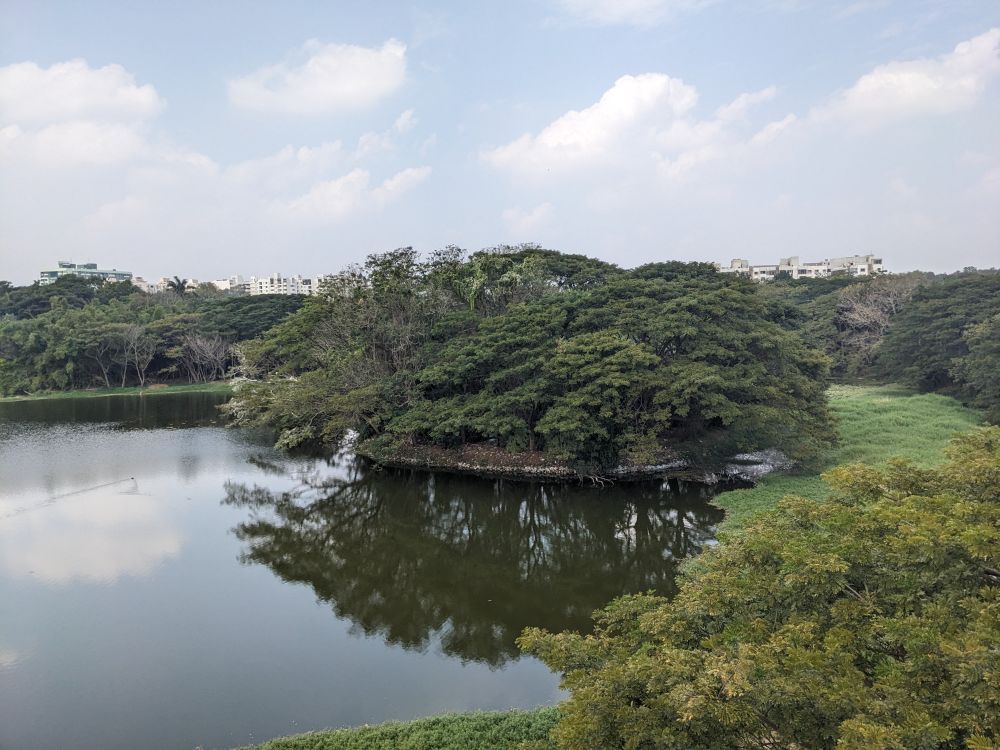
The 55-hectare big Karanji lake reflected the blue of the sky and was green at the edges for the mangroves circumscribing it. The sky was clear, and the day was bright. We opted for a self-paddle boat ride which cost thirty rupees per person for ten minutes. You take a ticket before, not later, as if you know how much time you would like to paddle. We got in, both of us strapped on a life jacket, and started paddling, being instructed by the staff to stay within the red flags put in the lake.
A few days ago, we watched flocks of migratory ibises, storks, pelicans, river terns, and lapwings at the Rangnathittu and the unnamed Kaveri backwaters. We were in luck again. Storks, egrets, cormorants, herons, and many other water birds splashed about in the water all around us. Some fished, many sat, and others dozed. As we paddled through the lake, we arrived at a bamboo-shaded corner of the lake where a large group of Indian spot-billed ducks were swimming. A boat was right in the middle of them, taking pictures. When they rowed away, we paddled our boat slowly along the ducks, keeping some respectful distance from them.
With the yellow spots on their bills, the ducks looked graceful in the olive-green water that rippled from their play. They paddled, flew, swam, chased each other, and preened. Though the sun was strong, under those creaking bamboo, swaying in our boat on the cool blue lake, gently caressed by the breeze, we didn’t complain of the strong sun and the heat.
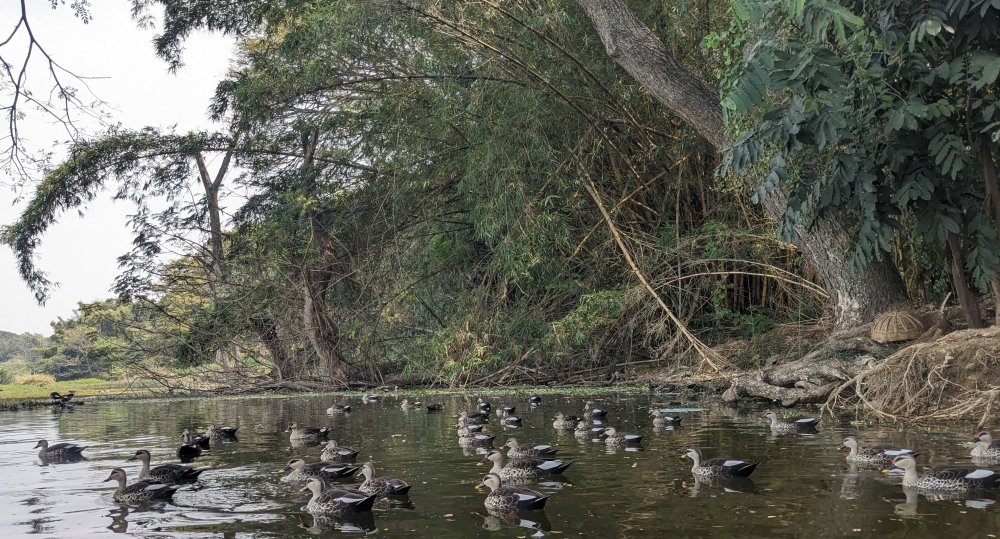
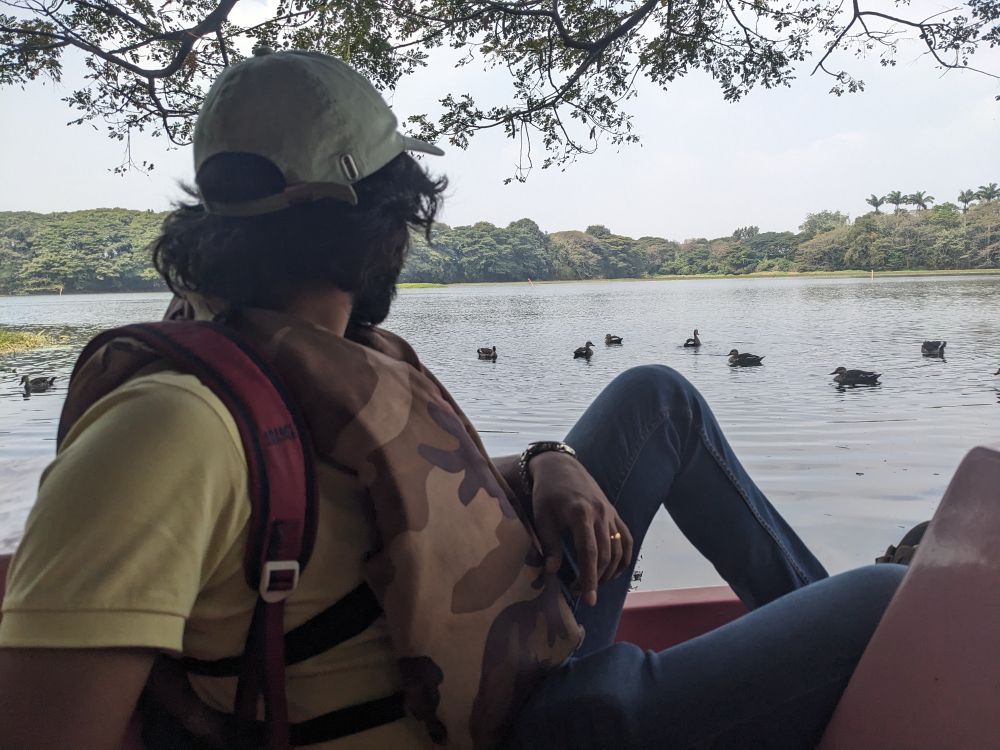
Grabbing the steer from Sagar, I said, “You don’t drive slow enough. You’ve to go close by the edges. I’ll do it.”
Ahead of the ducks, we paddled in gently, turning from the red flags. On the many green islands, weeded shores, and under the mangroves, birds snoozed in the sun, some with their necks turned into their wings. A stork flew above us. A pelican floated on her own time behind us. Cormorants sunbathed on thin branches with their wings open, as they do always.
Sagar and I couldn’t be more pleased. Few activities bring as much joy as immersing in nature does.
Meanwhile, many boats came, hurried, took pictures, paddled about, and left. The guys started calling out to when our time was due. “Red boat, red boat,” they shouted when there were many other red boats too. But we had told them, “We might take longer and will pay for the extra time when we get off.” We turned in at 12:46, forty minutes more than our paid-for twenty minutes, but they only asked us to pay for thirty. A miscalculation? Perhaps. We didn’t correct them, paid, and left to roam in the gardens around the lake.
Bamboo groves, waterfronts which were mostly barricaded or made inaccessible by the thick bamboo clusters marked with “be careful of snakes,” and benches on which couples made out incessantly. This I remember from the walk.
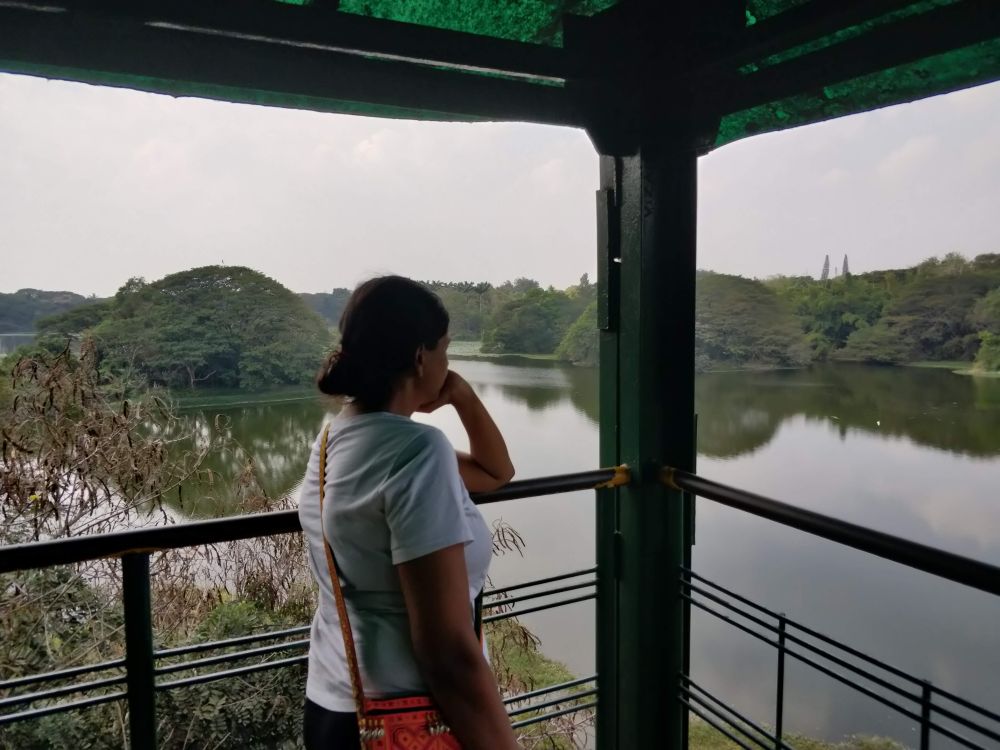
Google tells me Karanji Lake also has a walk-in aviary and a butterfly park. I think both were closed and made inaccessible at the time of my visit. At least the lake was clean now, for, of course, once the city sewage and other garbage was finding its way into the lake and the migratory birds had shun it for better places. After the restoration and cleaning efforts, the birds are back, and every day the Mysore Zoo authority that owns the lake makes about 50,000 every day from visitor tickets.
Just when I had peed behind a bush and we were thinking of getting out to head to Chamundeshwari Hill, a gate on our left intrigued us. The guard said it was the Natural History Museum, and it was free to visit.
“Let’s just see it once. Spend a few minutes in here.” We walked in.
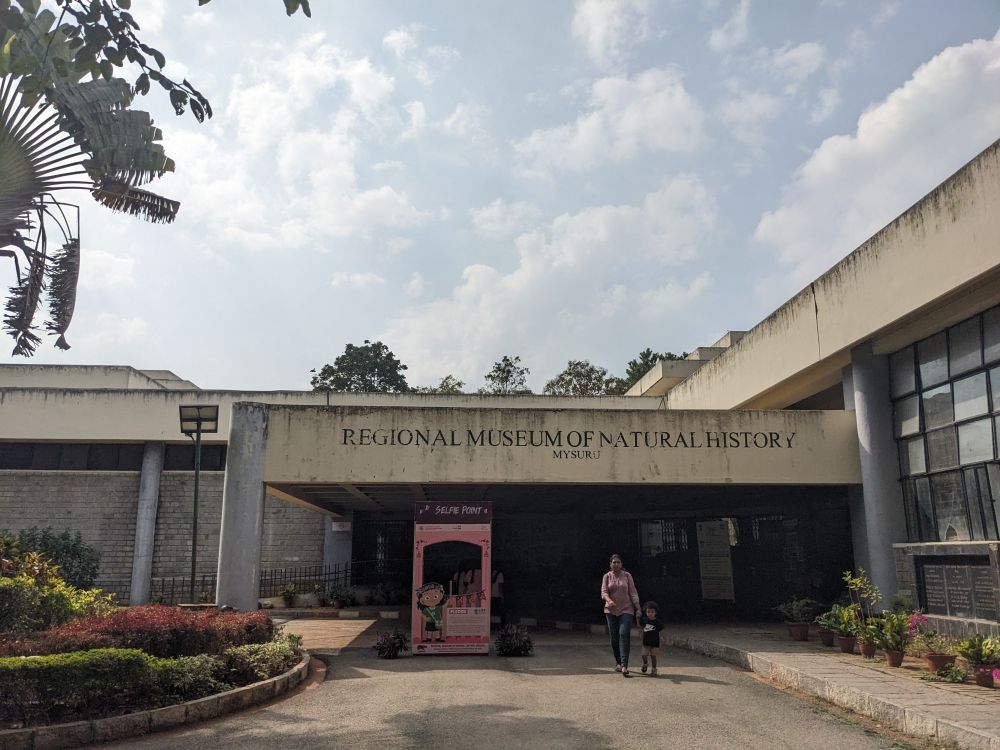
The museum had so many pictures, paintings, installations, relics, information, charts, and remains of the dead that we were in it for perhaps two hours, having no idea of when we came in and when we left. It was not a museum of history and natural life, it was a maze in which we lost ourselves for hours so curious were we. After the wire sculptures of elephants, there were the birds and reptiles, remains of the humpback mahaseer: fish that can weigh up to ninety kg, then the apes slowly rising to become men, and colorful paintings of all kinds of natural life.
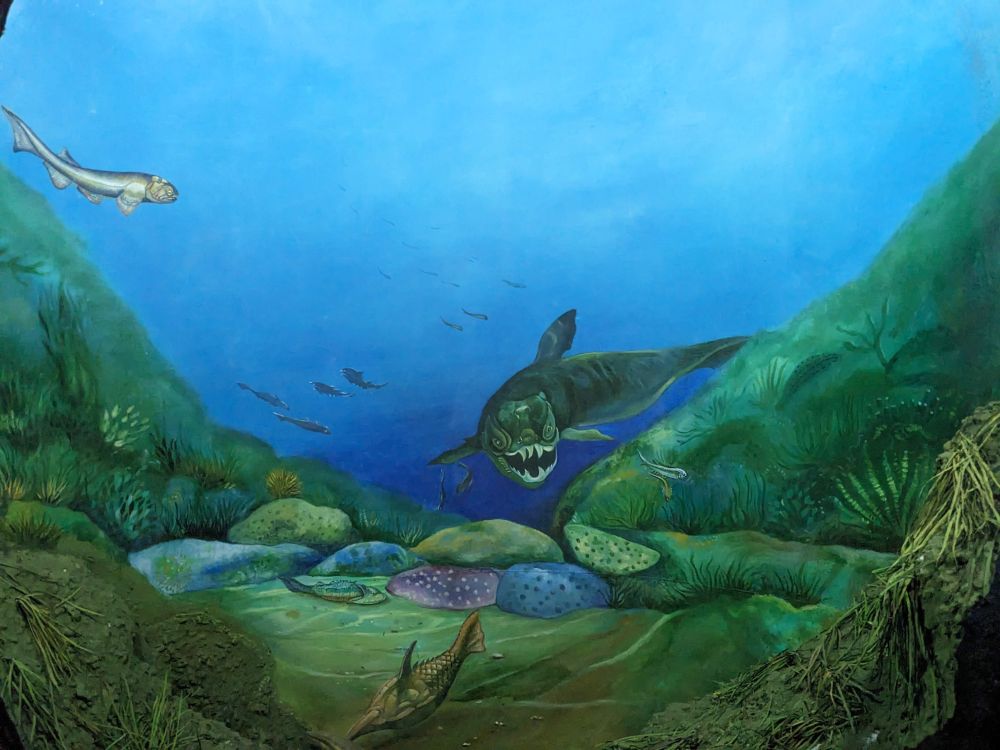
Well. Now we were tired, hungry, sleepy, and overloaded with information. Also, we had to visit Chamundi Hill: 15 km away from the city and 3500-m high from where we hoped to get good views of the city. After the visit, we had to drive to either a new destination or to another hotel near the hills perhaps. How will we manage?
“Let’s just eat first and then we’ll see.” Sagar said.
At Mysore cafe—which was the nearest decent place to sit and eat, we ordered two masala dosas and two coffees. One cannot have enough dosas in Karnataka.
“I’m looking for hotels in Mysore. It would be hard to drive further on after Chamundeshwari hill. There’s that podcast I had to record, too.” I said to Sagar, reminding him of my interview with Musafir Stories that night (the episode is still not out, I will add the link here when it does).
“I’m trying to find a place near the hill. Maybe it would be a nice lush area to stay in.” My eternal optimist picked up his phone.
We spent fifteen minutes searching but none of the hotels looked good. He couldn’t find anything near the hill either. Most places had extravagant prices but still didn’t appear nice.
“Let’s go to the hill and enjoy the sunset. This’ll work out,” Sagar said with the wisdom of a traveler who has seen enough hard days and more than enough times things working out: like when we drove from one Himachal village to another in a storm to find a better place to stay.
That was what we did.
Chamundeshwari was a disappointment though. On its top was a temple, as on most summits in India, and the whole place was crowded with stalls and people, touts and kiosks. Not even one square inch of space was left where a human, dog, or cart wasn’t passing through. There was so much rush that we didn’t want to return the next day on foot: we were thinking of hiking up to the top. While driving to the hill earlier, we had arrived at the base of the 1000 steps leading to the crest. They were crowded by a very religious-looking set-up with some men sitting at the beginning of the staircase. So we turned around and drove to the mountaintop. Now we were happy we didn’t spend hours climbing in the sun to arrive at such an underwhelming summit.
We just walked around, ignoring and shaking our heads at the touts all of whom wanted us to deposit our slippers without caring to ask if we were even going to the temple. Then Sagar and I walked to a viewpoint from where the valley could be seen but nothing so beautiful. To top it all, the temple had an entry ticket to it. Why?
At least, we had not parked in the paid parking. We were just on the side of the road, a hundred meters away from the main area of the hill. And it’s here seated in our car that I scrolled through the list of hotels again only to book Mannar. I called the hotel and told them we were planning to stay for one more day, were coming from Chamundi, and that our last experience had not been good so could they make sure to keep a clean room ready? We would be coming late and tired, I said.
The same kind and soft-spoken guy had picked up the phone for I could tell from his voice, “Come, madam, please come, room 207 will be ready,” and so on.
We drove with enthusiasm. My head was aching by the time we reached but I jumped up with glee to arrive at a room that was clean, bedding fresh, equipped with towels and so on. No smoke smell, the desk was good, and I settled in to record the podcast. Sagar left to buy food from the restaurant downstairs.
Two hours later, the podcast was done, I had been stuffed on palak paneer (spinach cottage cheese), juice, and cottage cheese chilly, and Sagar had bought chappals, shirts, and other things he needed.
The next morning I made another booking at Mannar, believing we were tired and one day of rest would do us good. Just in the last three months, we had made the long journey South from Himachal, visiting my parent’s home, attending a friend’s wedding in Nagpur, traveling to Ranthambore and Satpura National Park, pausing in Goa for four weeks, attending another wedding outside Bangalore, and then a couple of weeks in Bangalore before arriving in Mysore (while having such moments of beatific serendipity in Karnataka). Now not being fast but being slow was the aim.
Later when we went to the reception, the same attendant told us our booking hadn’t come through, the hotel was full, and just five minutes earlier they had blocked all online portals. Sold out. Also, he insisted they never took bookings from the particular website we had booked from. That was the unreliable EaseMyTrip.
We munched on our dosas and wondered what to do. We didn’t know yet that the same evening we would arrive at a lush quiet forest in Kerala after having driven through a dense Karnataka jungle in which we would spot a mother and baby elephant too.
We packed and drove further on, stopping outside a closed lake on whose lush gardens we wanted to figure out a new plan.
“Now what?” We asked each other.
“Let me drive you further on,” I straightened up in my seat and added, “I’m not tired today. I feel good. Let’s do this.”
Buckled up in the passenger seat, Sagar looked down into his phone and declared with comforting clarity, “We can go to the Kerala side of the national forests of Bandipur and Nagarhole. Here in Karnataka, the forest accommodations are crazy expensive. But we can find something good on that side. We can go to Wayanad, it’s all the same forest but in Kerala. I’m sure we can find a good place there.”
So that was what we did.
The road can always be trusted. You never know what it has in store for you. You don’t always know the right thing to do. However, when you make a wrong decision, the road sometimes corrects it for you. And no matter what happens, if your heart is in the right, you arrive in the right place too.
Where to stay on your Mysore Trip?
Do consider Mannar Residency, the hotel I stayed in for five days and that I have described above in detail. The location is walkable from the Mysore Palace, lies in the centuries-old Devaraja market so one is surrounded by temples, spices, and food, and their restaurant downstairs serves delicious and reasonably-priced food.
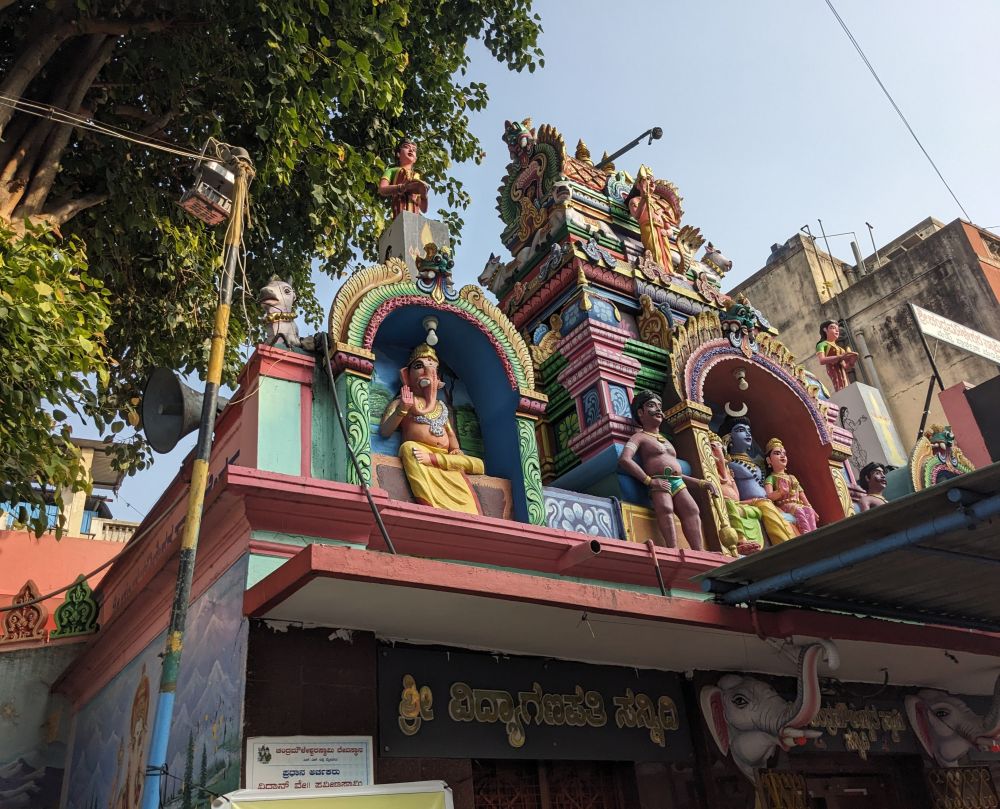
Ask for a higher floor room to avoid the street noise.
Go here to look at Mannar’s reviews and pictures and to book.
If this doesn’t work out, browse the list of hotels in Mysore on Booking.
Did you like this account of my travels in Mysore? Have you been to the city?
*****
My much-awaited travel memoir
Journeys Beyond and Within…
is here!
In my usual self-deprecating, vivid narrative style (that you love so much, ahem), I have put out my most unusual and challenging adventures. Embarrassingly honest, witty, and introspective, the book will entertain you if not also inspire you to travel, rediscover home, and leap over the boundaries.
Grab your copy now!
Ebook, paperback, and hardcase available on Amazon worldwide. Make some ice tea and get reading 🙂
*****
*****
Want similar inspiration and ideas in your inbox? Subscribe to my free weekly newsletter "Looking Inwards"!

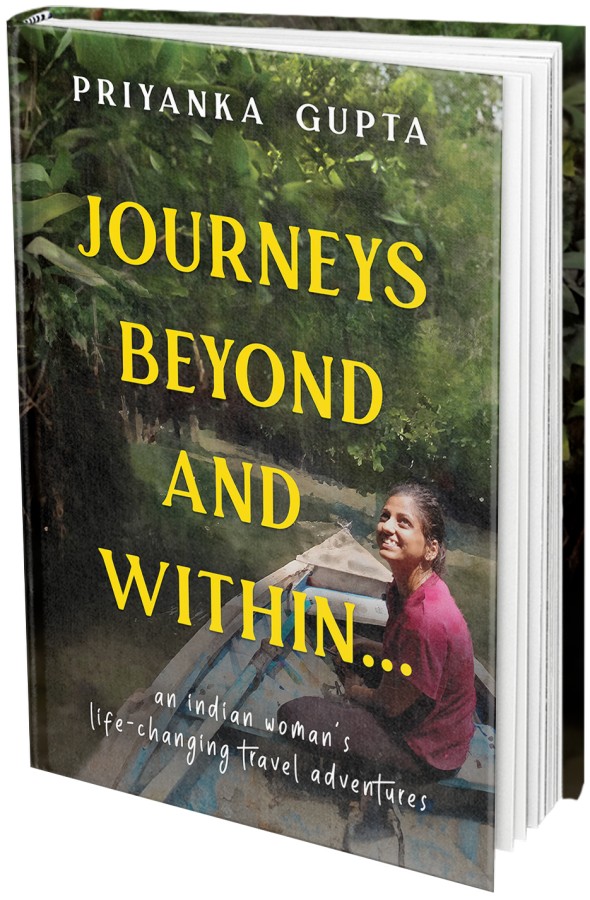
Your travel experience truly motivates us, I love the way you explore every aspect of trek !!
This is what actually travel is !!!